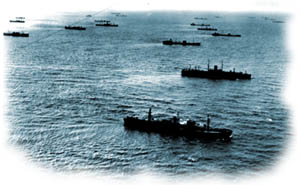|
|
|||||||
|
|
|||||||
 | |||||||
Home | |||||||
|
|
A Memorial to The Seamen of The Great War
The Imperial War Graves Commission erected the Hollybrook Memorial in Hollybrook Cemetery, Southampton, England. It records the names of those who went down in vessels mined or torpedoed in home waters, as well as elsewhere in the world, from transports to hospital ships, and whose graves are not known. The total number of officers and men named on this Memorial is 1,868, and 64 of these are Canadians.
Hollybrook Cemetery is in Chilworth Road, Shirley, three kilometres North of Southampton West railway station. It was opened in 1913, and covers an area of 19 hectares. It stands on high ground, but an intervening ridge cuts off the view of Southampton. The War Plot is immediately within the entrance with the War Cross in front of it. On a terrace at the back of the Plot is the screen wall that forms the Memorial, on which the names of the dead are carved. The general inscription is in these words: 
1914 TO THE GLORY OF GOD AND
The War at SeaWhen the war began in 1914 Canada had an embryonic naval service consisting of fewer than 350 men and two ships, HMCS Rainbow and HMCS Niobe. It was decided that Canada's war effort would be best concentrated on the army and, therefore, the protection of Canada's coasts and shipping in Canadian waters was handed over to the Royal Navy. The share of the Royal Canadian Navy in defence was small, but, important. The RCN assumed responsibility for such services as examining and directing shipping in Canadian ports; radio-telegraph services, vital to the Admiralty's intelligence system; operation of an auxiliary fleet which engaged in minesweeping and patrolling operations. In 1916, when the threat of submarine warfare spread to North American waters, the Canadian government undertook, at the request of the British Admiralty, to build up a patrol force of 36 ships. In addition, Canadians made up a substantial part of the ships' companies of Canada's cruisers and the two submarines, which had been acquired by the British Columbia government. At the end of the war the RCN numbered more than one hundred war vessels and about 5,500 officers and men -- the nucleus of a future, effective naval force. Canada also made a direct contribution to the war at sea by providing men and ships for the Royal Navy and for other Allied powers. Although the shipbuilding industry in Canada was not highly developed in 1914, a considerable number of warships were built or assembled in Canada during the war. Some 3,000 Canadians were recruited by the RCN for service with the Royal Navy, and an unrecorded number enlisted directly. Canadians served in many parts of the world. On November 1, 1914 Canada lost her first men at sea when four young midshipmen went down with the HMS Good Hope at the Battle of Coronel off the west coast of Chile. *While the "1855" inscribed in the panel must remain, the names commemorated now total 1,868. |
||||||
|
|
|||||||